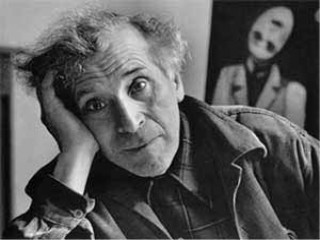
Chagall Marc (En.) biography
Date of birth : 1887-07-07
Date of death : 1985-03-28
Birthplace : Vitebsk, Belarus
Nationality : Russian-French
Category : Arts and Entertainment
Last modified : 2010-05-26
Credited as : Modernism artist painter, ,
As a pioneer of modernism and one of the greatest figurative artists of the twentieth century, Marc Chagall achieved fame and fortune, and over the course of a long career created some of the best-known paintings of our time. According to art historian Michael J. Lewis, Chagall was considered to be "the last survivor of the first generation of European modernists." For decades he "had also been respected as the world's preeminent Jewish artist." Using the medium of stained glass, he produced windows for the cathedrals of Reims and Metz, windows for the United Nations, and the Jerusalem Windows in Israel. He also did large-scale paintings, including the ceiling for the Paris Opéra.
Regarded as one of the father’s of surrealism, Marc Chagall became famous for his contributions to the theory and practice of art in the School of Paris. He concentrated on classical themes in his art with a twist of modernity and abstract additions that had never been done before.
Born to poor Jewish parents, young Marc would entertain himself in the village that would inspire his later work. One of these works dubbed Cow and Fish Playing the Violin, although bizarre, was later regarded as pushing art back into modernity. He attended the Society for the Protection of the Arts in Russia and was therein introduced to the art of Paris where it brought back nostalgia to his early childhood village life.
Marc Chagall was able to go to Paris in order to meet those who were leading the movements of the day. He was able to show his work in the Salon des Independants and the Salon d’Automne, which won him some views from the discerning public eye. His show in Germany, however, at the Der Sturm Gallery in Berlin shot him to the top of the list of internationally famous artists and won him support from those who admired his works.
Upon returning to Russia to promote his work further, he ran into some trouble with his new “vogue” style. When he received the cold shoulder from his motherland, he returned to Paris and Berlin, never to return to Russia. During this time, he began traveling the Middle East and learning more about religion, which affected his art greatly. His work began focusing on stories from the Bible.
Chagall moved to the United States and was successful designing costumes for ballets and other theatrical performances. In the mid 1980s, he returned to France and completed one of his most famous works entitled Arabian Nights. He worked for the next few decades in not only painting, but in ceramics and other lithographic works. His works have appeared in quite prominent locations – his stained-glass work appears in the United Nations building in New York. A museum was opened in Nice in his honor and his work has appeared in the Louvre several times, most honorably in 1977 when over 60 of his paintings were on display.
He was known to have two basic reputations, writes Lewis – as a pioneer of modernism, and as a major Jewish artist. He experienced modernism's golden age in Paris, where "he synthesized the art forms of Cubism, Symbolism, and Fauvism, and the influence of Fauvism gave rise to Surrealism." Yet throughout these phases of his style "he remained most emphatically a Jewish artist, whose work was one long dreamy reverie of life in his native village of Vitebsk." "When Matisse dies", Pablo Picasso remarked in the 1950s, "Chagall will be the only painter left who understands what colour really is."
















